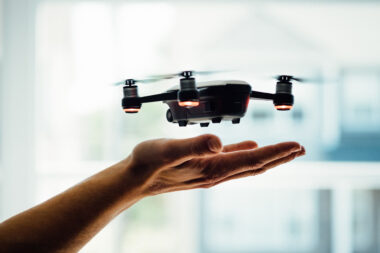Museums, traditionally revered as repositories of culture and history, are undergoing a transformative evolution with the integration of augmented reality (AR). This article delves into the innovative use of AR in museums, exploring how this technology transcends the boundaries of conventional exhibits, creating interactive and immersive experiences that forge a profound connection between visitors and cultural artifacts.
Implementation and Application of Augmented Reality in Museums
Augmented Reality (AR) has become a transformative force in the museum landscape, enhancing visitor engagement and enriching the overall museum experience. Here’s an in depth exploration of the implementation and application of augmented reality in museums.
Interactive Exhibits:
Implementation: AR transforms traditional exhibits into interactive experiences. Museums deploy AR technology to overlay digital content onto physical artifacts, enabling visitors to access additional information, animations, and interactive elements.
Application: Visitors can use AR enabled devices, such as smartphones or AR glasses, to explore exhibits dynamically. For instance, they can view 3D reconstructions of ancient artifacts or witness historical events through augmented reality animations.
AR guided Tours:
Implementation: AR guided tours leverage location based technology to provide visitors with contextual information as they move through the museum. AR enhanced maps and navigation tools guide visitors seamlessly from one exhibit to another.
Application: Visitors receive real time information about the exhibits they encounter, enhancing their understanding of the museum’s layout and the significance of each display.
Immersive Learning Experiences:
Implementation: Museums integrate AR to create immersive learning experiences. Educational content, including videos, quizzes, and additional historical context, is layered onto exhibits to enrich the learning process.
Application: Visitors engage with educational content in real-time, gaining deeper insights into historical events, scientific concepts, or artistic techniques associated with each exhibit.
Virtual Reconstructions:
Implementation: AR is used to virtually reconstruct historical sites, artifacts, or scenes. Visitors can witness how ancient structures looked in their prime or explore virtual environments that bring historical contexts to life.
Application: This application allows visitors to bridge the temporal gap and experience historical events or places in a more vivid and tangible manner.
Augmented Art Installations:
Implementation: Museums collaborate with artists to create augmented reality art installations. Traditional artworks are overlaid with digital enhancements, animations, or interactive elements.
Application: Visitors can explore the convergence of traditional and digital art, offering a dynamic and interactive interpretation of artistic expression.
Personalized Experiences:
Implementation: AR enables museums to offer personalized experiences based on visitor preferences. Visitors can choose thematic pathways or customize their tours, ensuring that the museum journey aligns with their interests.
Application: Personalization fosters a sense of connection, making the museum visit more meaningful and tailored to the individual preferences of each visitor.
Socially Shared Experiences:
Implementation: Social media integrations within AR experiences allow visitors to share their museum experiences with friends and followers. Shared AR experiences foster a sense of community and extend the museum’s reach.
Application: Visitors share photos, videos, or insights about their favorite exhibits, creating a digital dialogue around museum content.
Accessibility Features:
Implementation: Museums use AR to enhance accessibility features for visitors with diverse needs. AR can provide audio descriptions, sign language interpretations, or tactile feedback for a more inclusive experience.
Application: Visitors with disabilities can engage with exhibits in ways that cater to their specific needs, ensuring that the museum is accessible to a broader audience.
AR based Events and Exhibitions:
Implementation: Museums host AR based events and exhibitions that go beyond traditional displays. Temporary exhibits or events leverage AR to create unique and dynamic showcases.
Application: Visitors attending these events experience a blend of physical and digital elements, pushing the boundaries of what a museum exhibition can offer.
Continued Innovation:
Implementation: Museums continually innovate by exploring new applications of AR technology. This may include integrating haptic feedback, incorporating artificial intelligence for interactive guides, or experimenting with AR-based games.
Application: Innovation ensures that museums remain dynamic and responsive to technological advancements, offering visitors novel and evolving experiences.
Hardware and Software Requirements for Augmented Reality in Museums
Implementing augmented reality (AR) in museums requires a combination of hardware and software solutions to deliver immersive and interactive experiences for visitors. Here’s an overview of the key components necessary for a successful AR deployment in museums:
Hardware Requirements:
AR enabled Devices:
Description: Visitors need devices capable of displaying AR content. These include smartphones, tablets, or AR glasses.
Application: AR enabled devices serve as the primary interface for visitors to access augmented content seamlessly.
Smartphones and Tablets:
Description: Widely accessible devices with built in cameras and processing power suitable for running AR applications.
Application: Visitors can use their smartphones or tablets to scan exhibits, access additional information, and engage in interactive AR experiences.
AR Glasses:
Description: Dedicated AR glasses provide a hands-free experience, overlaying digital content onto the user’s field of view.
Application: AR glasses enhance mobility and allow visitors to experience exhibits without the need to constantly hold a device.
Beacon Technology:
Description: Bluetooth Low Energy (BLE) beacons placed strategically within the museum to enable location based AR experiences.
Application: Beacons enhance precision in delivering AR content by recognizing a visitor’s location and triggering relevant information based on proximity to exhibits.
Haptic Feedback Devices:
Description: Devices that provide tactile feedback to enhance the sensory experience.
Application: Integrating haptic feedback enhances interactivity, allowing visitors to feel virtual textures or receive vibrations for a more immersive encounter with exhibits.
Software Requirements:
AR Content Creation Tools:
Description: Software tools for designing and creating AR content, including 3D models, animations, and interactive elements.
Application: Content creation tools empower museums to develop engaging and contextually relevant AR experiences for exhibits.
AR Development Platforms:
Description: Platforms that facilitate the development and deployment of AR applications.
Application: AR development platforms streamline the creation process and ensure compatibility across various devices.
Marker Recognition Software:
Description: Software that recognizes specific markers or triggers within the museum environment to initiate AR content.
Application: Marker recognition enhances the accuracy and synchronization of AR content with physical exhibits.
Location based AR Software:
Description: Software that uses GPS or beacon technology to provide location specific AR content.
Application: Location based AR software ensures that visitors receive information relevant to their specific position within the museum.
Mobile App Development:
Description: Custom mobile applications designed for AR experiences.
Application: Museums can create dedicated apps that serve as the interface for visitors to access AR content seamlessly.
AR Content Management System (CMS):
Description: CMS designed to organize, update, and manage AR content.
Application: An AR CMS streamlines the process of content updates, ensuring that information remains current and relevant.
Data Analytics Tools:
Description: Tools for collecting and analyzing data on visitor interactions with AR content.
Application: Analytics provide insights into visitor engagement, helping museums refine and optimize AR experiences based on user behavior.
Accessibility Software:
Description: Software that ensures AR experiences are accessible to individuals with disabilities.
Application: Accessibility software enhances inclusivity, providing features such as audio descriptions or text to speech functionality.
Security and Privacy Measures:
Description: Protocols and encryption measures to safeguard user data and maintain privacy.
Application: Security measures are essential to protect visitor information and ensure a secure AR environment.
The Evolution of Museums with AR:
The integration of AR in museums marks a departure from static exhibits, ushering in an era of dynamic storytelling. Traditional museums are evolving into interactive spaces that leverage AR to engage visitors in unprecedented ways. The evolution is not merely technological but represents a shift in the very essence of how museums communicate narratives.
Interactive Exhibits in AR:
AR technology enriches the museum experience by overlaying digital content onto the physical world. Visitors equipped with AR-enabled devices, such as smartphones or AR glasses, can explore exhibits that come to life with additional layers of information, animations, and interactive elements. From historical artifacts to works of art, exhibits are no longer confined to their physical dimensions but extend into the digital realm.
Fostering Engagement and Curiosity:
One of the key advantages of AR-powered museums is their ability to captivate visitors and stimulate curiosity. AR facilitates interactive storytelling, enabling visitors to delve deeper into the context, significance, and stories behind each artifact. Users can, for instance, virtually reconstruct ancient structures, watch historical events unfold, or interact with 3D representations of artifacts, fostering a sense of exploration and discovery.
Immersive Learning Experiences:
AR-powered museums transcend the traditional boundaries of learning. Educational content is seamlessly integrated into exhibits, providing visitors with a rich tapestry of information. Whether it’s a historical timeline, scientific data, or artistic interpretations, AR transforms the museum into a dynamic classroom, catering to diverse learning styles and interests.
Personalized Journeys through AR:
AR allows for personalized museum journeys tailored to individual preferences. Visitors can choose thematic pathways, opting for immersive experiences based on their interests. AR driven personalization fosters a more intimate connection with the content, ensuring that each visitor’s experience is unique and meaningful.
Bridging Past and Present:
AR serves as a bridge between the past and present, creating a temporal dialogue between artifacts and contemporary narratives. Historical figures can come to life through AR avatars, and visitors can witness cultural evolution over time. This temporal juxtaposition fosters a deeper understanding of the interconnectedness of history and contemporary life.
Social Connectivity in Museums:
AR powered museums enhance the social aspect of the visitor experience. Shared AR experiences enable groups of visitors to engage collaboratively, fostering dialogue and shared discoveries. Additionally, AR features may include social media integrations, allowing visitors to share their experiences and insights, further extending the museum’s reach beyond its physical walls.
Overcoming Physical Constraints:
AR transcends physical constraints, enabling museums to overcome limitations in space and resources. Virtual exhibits can be seamlessly integrated with physical ones, expanding the narrative possibilities and accommodating a broader range of artifacts and themes.
Challenges and Considerations:
While AR brings immense potential, museums adopting this technology must address challenges such as accessibility, device compatibility, and the balance between digital and physical experiences. Ethical considerations, such as data privacy and the preservation of the authentic museum experience, also merit careful attention.
The Future of AR in Museums:
As technology continues to advance, the future of AR in museums holds promise for even more sophisticated and immersive experiences. Innovations such as AR based navigation, artificial intelligence driven interpretive guides, and further integration of haptic feedback may redefine how visitors engage with cultural institutions.
In conclusion, AR powered museums represent a paradigm shift in the way we interact with cultural heritage. By transforming traditional exhibits into interactive, immersive experiences, AR fosters a deeper connection between visitors and artifacts, enriching the museum journey and redefining the boundaries of cultural exploration. As technology continues to evolve, AR stands as a dynamic force shaping the future landscape of museum experiences.



